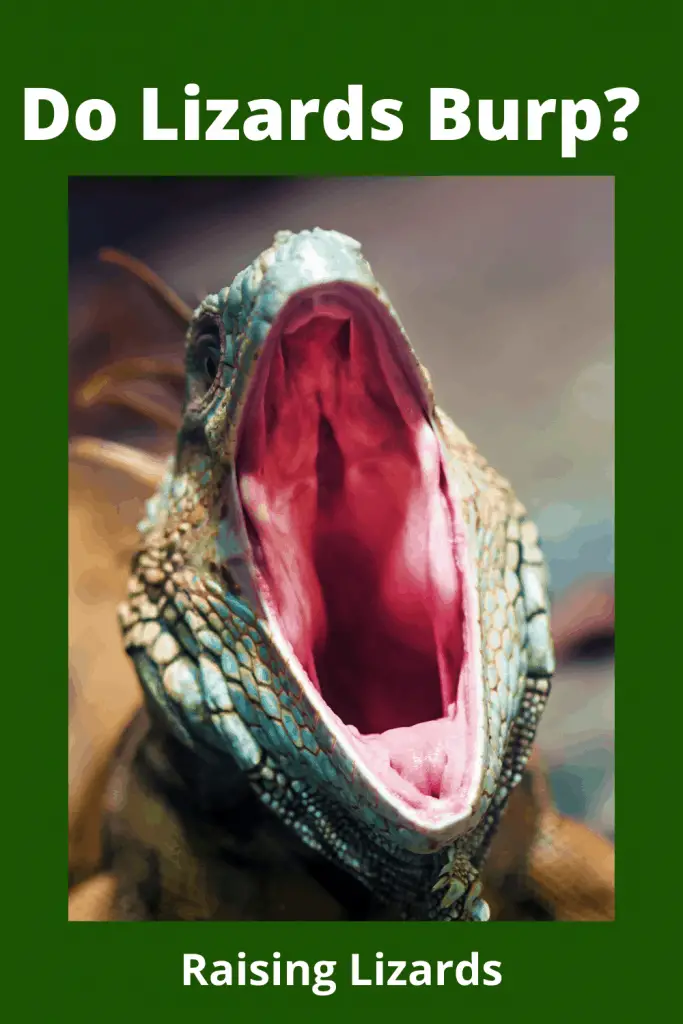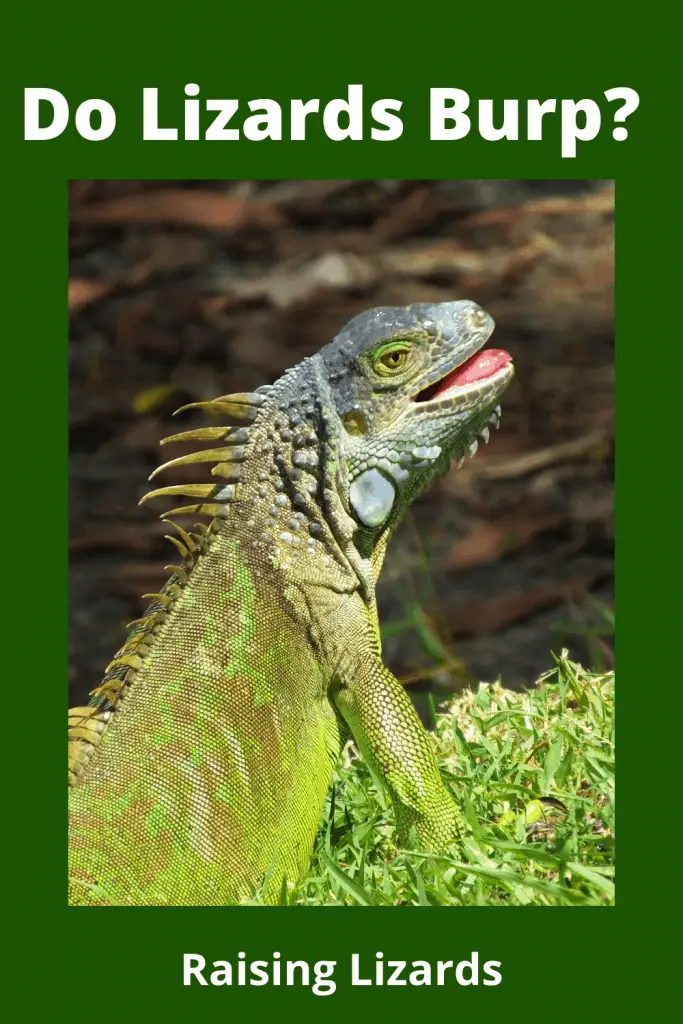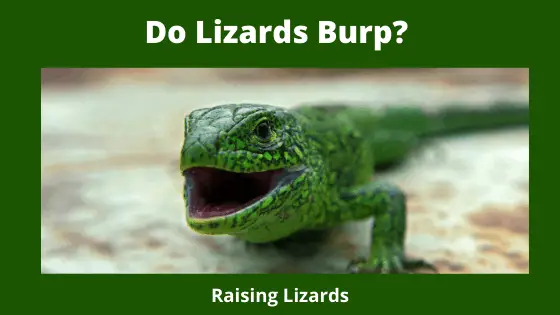How Do Lizards Burp? The act to expel air from the stomach through the mouth is called belching. This phenomenon occurs when the stomach distends, expands, or swallows too much air. Belching is also termed as burping or eructation and is the act to release the air to reduce distention.

The common cause of burps is that the stomach fills up with swallowing air and there are several reasons why the air more than normal is swallowed. Burping is a common phenomenon and occurs in almost all types of animals including reptiles. Lizards are polyphyletic and widespread all over the world. One of the common questions regarding the digestive tract of lizards is that whether they burp or not?
The simple answer to this is yes, lizards burp. Burping is actually the release of gas from the upper digestive tract, including the esophagus and stomach through the mouth and usually the sound is audible.
Do Lizards Burp? Causes of Lizards Burping:
There are different causes of Lizard burping that include swallowing of air, eating or drinking, and subsequently expelling the air, which is primarily composed of nitrogen and oxygen. Different compounds used in pet drugs, including metformin and exenatide cause burping especially when given in high doses. The phenomena of burping are often combined with other symptoms such as dyspepsia (poor digestion), nausea, and heartburn, which could be a sign of an ulcer or hiatal hernia and should be reviewed by a vet.
The other causes of burping include food allergy, gallbladder diseases, esophageal reflux, and acid reflux disease. Intestinal gas is a topic that is usually avoided by people and they consider it difficult, but almost all types of animals face gas in the intestinal tract.
This intestinal gas contributes to bloating sensation (fullness), belching or burping, abdominal cramps, and flatulence. The symptoms are usually resolved once the gas is released by belching or flatulence.
Bloating refers to fullness in the upper abdomen and is influenced by the gas or food accumulation in the stomach. Sometimes it occurs with the normal amount of gastric gas.
The gas is generally a combination of swallowed air or undigested carbohydrates or the one produced because of bacterial action. As the animals swallow air during the process of eating, they can have excess swallowing during the chewing process of their food.
Just like humans, animals also have emotions, anxiety in animals, including the pet lizards, which may result in swallowing excess air. The significant amount of gas that enters the stomach and small bowel in 24 hours leads to belching, bloating, or flatulence.
The diet of lizards might include carbohydrates that can’t be digested by the enzymatic action in the intestine and reach the colon where bacteria metabolize it into hydrogen or carbon dioxide gasses that contributes to flatulence.
This might cause abdominal cramps, bloating, and flatulence when certain types of saccharides are taken in the diet because of the absence of the enzyme.
The Burping Risk Factor:
As mentioned earlier, excessive swallowing of air contributes to blenching and flatulence. Lizards with altered anatomy due to an accident or abnormal development or with a certain rheumatologic disorder may be at an increased risk of bacterial overgrowth in the small intestine that leads to blenching, bloating, or flatulence.
Usually, the abdominal distention is not present when the lizards are at rest or are lying flat, the most likely explanation, for this reason, is the weak abdominal muscles that extend from the lower rib cage to the pelvis due to stretching and loss of muscle tone.
Some lizards facing any digestive disorder, including heartburn (movement of gastric juices by antiperistalsis movement of the esophagus) or any other stomach disorder may swallow the air for relief. Abdominal distension is an indication of weak abdominal muscles.
Postnasal discharge from the sinus problems can also cause air swallowing and should be considered.
Lizard Foods That Can Cause Belching:
Lizards feed on a variety of foods, some are carnivorous and feeds on cockroaches, beetles, mealworms while others feed on strawberries, lettuce, green beans and are herbivorous. The few remaining need combination of both. The bearded dragons from deserts need a combination of both plants and insects.
As far as blanching is concerned, the lizards with the carnivorous mode of nutrition are less prone to bolting up the gas in the GIT tract. In the herbivorous mode of nutrition, the fibers and different saccharides in plants build up the gas in the GIT tract of the lizard. Once the gas develops, it needs to be eliminated from the body. The different processes involved in the elimination of the gas are blenching and farting.
Contribution of Fiber-Rich Food in Flatulence:
Fibers are plant-based materials and are not digested by the GIT tract and are the mainstays in the treatment of constipation. The fibers bind with water and keep the water within the intestine. The fiber and water add bulk to the stool and the water content softens the stool, but the increased gas (flatulence) is the common side effect of high fiber diets.
The gas develops due to the action of the bacteria that produce the gas as a by-product of the digestion of fiber. The type of fiber varies from source to source, some are digested to a much greater extent by the action of bacteria than the others. The better the digestion more is the production of gas.
All types of fibers, despite their source cause flatulence, but due to the varying degree of digestibility and bacterial action, the amount of gas produced varies. Even the digestibility of the same fiber by the same bacterial species varies from individual to individual.
The most common natural source of fibers includes fruits and vegetables and are more likely to cause flatulence. Most lizards feed on such fruits and vegetables that are rich in fibers and ultimately results in the development of the gas. Once gas develops, it is eliminated by the body, otherwise, it could be fatal.

Blenching is the elimination of these gases via mouth while farting involves their elimination through the anal area. Learning about what lizards can eat is tricky because there are different types of lizards in the world. Different species vary according to the habitats or places.
Some are found in deserts, rainforests, backyards, and rocky places and range from a few inches to the size of a fully grown man. The diet of lizards varies according to their habitat, size, and the breed’s mode of nutrition. The development of gas and the amount of gas that develops is dependent on all these factors and contributes to blenching (the burping process). To conclude, we can say that, yes lizards burp.
Conclusion
The frequency of occurrence of burps depends upon the diet of the lizard, it’s a mode of nutrition and the lizard species. The major contributor to the occurrence of burp is fiber-rich food. Different digestive problems discussed above, and the excess swallowed air also contributes to the blanching process. Sometimes, the lizards burp when their stomach is full and they don’t need more to eat while in others, it’s the indication that the food is digested by bacteria. In short, burping is a natural and unharmful process
Lizard Habitats and Facts
| Lizard Type | Foods | Adult Size | Vivarium Type | Eggs | Temperament | Country Origin | Price |
|---|---|---|---|---|---|---|---|
| Ameiva | Insects | 20 " | Tropical Woodland | 2-8 | Aggressive | Central, South America | $ 49.99 |
| Alligator Lizard | Insects | 20" | Semi- Aquatic | 6-12 | Aggressive | North America | $ 18 |
| Asian Water Dragons | Carnivorous | 40" | Tropical Woodlands | 8-16 | Aggressive | Asia | $ 18 - $ 80 |
| Panther Chameleon | Insects | 12" | Tropical Woodlands | 30-50 | Aggressive | Madagascar | $ 150 - $ 600 |
| Jacksons Chameleon | Insects | 14" | Temperate Woodlands | Up to 30 Live Young | Aggressive | East Africa | $ 75 - $175 |
| Giant Day Gecko | Insects | 10" | Tropical Woodlands | 2 | Aggressive | Madagascar | $ 79.99 |
| Leopard Gecko | Insects | 10" | Desert | 2 | Aggressive | Asia, India | $ 30 - $ 45 |
| Tokay Gecko | Insects | 14" | Tropical Woodland | 2 | Aggressive | Southeast Asia, New Guinea | $ 39.99 |
| Blu Tongue Skink | Vegetarian | 20" | Savannah | 6-25 | Aggressive | New Guinea, Australia | $ 150 - $ 649 |
| Common Walled Lizard | Insects | 8" | Savannah | 3-8 | Aggressive | Central Europe | $ 460 - $ 600 |
| Green Lizard | Insects | 16" | Savannah | 6-20 | Aggressive | Europe, Southern Asia | ? |
| Green Iguana | Vegetarian | 60" | Tropical Woodland | 20-40 | Aggressive | Central, South America | $ 39 - $ 55 |
| Desert Iguana | Vegetarian | 15" | Desert | 3-10 | Aggressive | USA, Mexico | $ 34.99 |
| Six Lined Racerunner | Insects | 11" | Savannah | 4-6 | Aggressive | USA | $ 29.99 |
| Chinese Crocodile Lizard | Carnivorous | 12" | Semi- Aquatic | 2-12 Live Young | Aggressive | China | $ 1200 |
| Collared Lizard | Insects | 14" | Desert | 4-24 Eggs | Aggressive | USA, Mexico | $ 53.99 |
| Western Fence Lizard | Insects | 9" | Savannah | 6-13 | Aggressive | USA | $ 19.99 |
| Chuckwalla | Vegetarian | 18" | Desert | 6-13 eggs | Aggressive | Mexico | $ 88.99 |
| Green Anole | Insects | 9" | Tropical Woodland | 2 | Aggressive | Southern USA | $ 10.00 |
| Brown Anole | Insects | 8" | Tropical Woodland | 2 Eggs | Aggressive | Caribbean, Central America | $ 3.99 - $ 7.99 |
| Knight Anole | Insects | 22" | Tropical Woodland | 1-2 | Aggressive | Cuba | $ 39.99 |
| Nile Monitor | Carnivorous | 79" | Savannah | 10-60 | Aggressive | Egypt | $ 69.99 |
| Bosc's Monitor | Carnivorous | 69" | Savannah | 10-50 | Aggressive | Central Africa | $ 100 - $ 150 |
| Bearded Dragon | Insects | 20" | Desert | 15-30 | Social | Australia | $ 60 - $ 400 |
| Agama | Insects | 16" | Savannah | 10-20 | Aggressive | North Africa | $ 24.99 |
| Five Lined Skink | Insects | 9" | Temperate Woodland | 15 | Aggressive | Africa | $ 10 |
| Red Tailed Rock Lizard | Insects | 8" | Savannah | 2-4 | Aggressive | South Africa | ? |
Food
Size
Vivarium Type
Country Origin
Price
Eggs
Temperament
Approx Cost


